The AMD Radeon R9 Fury X Review: Aiming For the Top
by Ryan Smith on July 2, 2015 11:15 AM ESTCompute
Shifting gears, we have our look at compute performance. As an FP64 card, the R9 Fury X only offers the bare minimum FP64 performance for a GCN product, so we won’t see anything great here. On the other hand with a theoretical FP32 performance of 8.6 TFLOPs, AMD could really clean house on our more regular FP32 workloads.
Starting us off for our look at compute is LuxMark3.0, the latest version of the official benchmark of LuxRender 2.0. LuxRender’s GPU-accelerated rendering mode is an OpenCL based ray tracer that forms a part of the larger LuxRender suite. Ray tracing has become a stronghold for GPUs in recent years as ray tracing maps well to GPU pipelines, allowing artists to render scenes much more quickly than with CPUs alone.
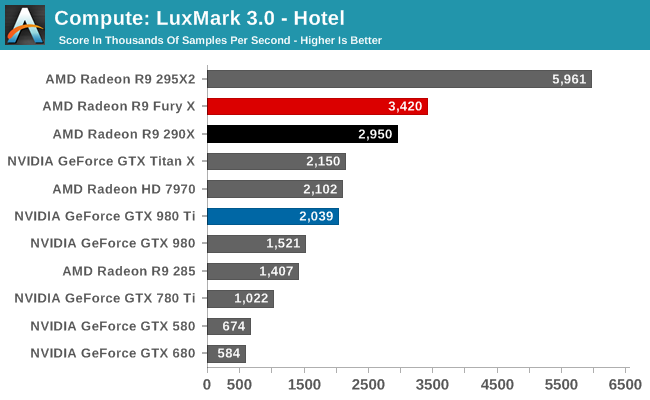
The results with LuxMark ended up being quite a bit of a surprise, and not for a good reason. Compute workloads are shader workloads, and these are workloads that should best illustrate the performance improvements of R9 Fury X over R9 290X. And yet while the R9 Fury X is the fastest single GPU AMD card, it’s only some 16% faster, a far cry from the 50%+ that it should be able to attain.
Right now I have no reason to doubt that the R9 Fury X is capable of utilizing all of its shaders. It just can’t do so very well with LuxMark. Given the fact that the R9 Fury X is first and foremost a gaming card, and OpenCL 1.x traction continues to be low, I am wondering whether we’re seeing a lack of OpenCL driver optimizations for Fiji.
For our second set of compute benchmarks we have CompuBench 1.5, the successor to CLBenchmark. CompuBench offers a wide array of different practical compute workloads, and we’ve decided to focus on face detection, optical flow modeling, and particle simulations.
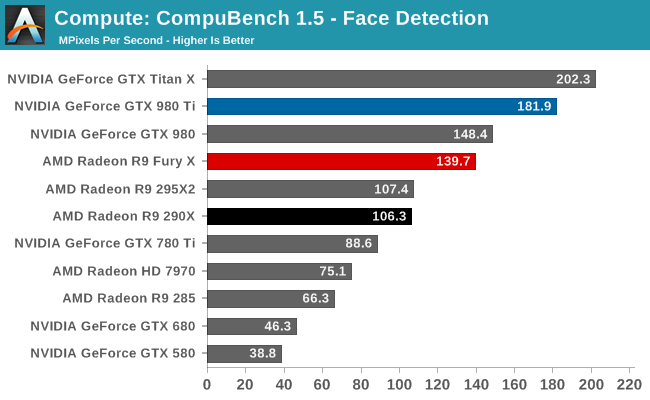
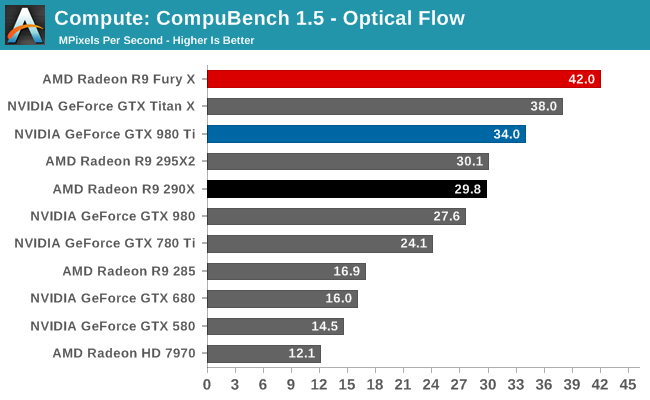

Quickly taking some of the air out of our driver theory, the R9 Fury X’s performance on CompuBench is quite a bit better, and much closer to what we’d expect given the hardware of the R9 Fury X. The Fury X only wins overall at Optical Flow, a somewhat memory-bandwidth heavy test that to no surprise favors AMD’s HBM additions, but otherwise the performance gains across all of these tests are 40-50%. Overall then the outcome over who wins is heavily test dependent, though this is nothing new.
Our 3rd compute benchmark is Sony Vegas Pro 13, an OpenGL and OpenCL video editing and authoring package. Vegas can use GPUs in a few different ways, the primary uses being to accelerate the video effects and compositing process itself, and in the video encoding step. With video encoding being increasingly offloaded to dedicated DSPs these days we’re focusing on the editing and compositing process, rendering to a low CPU overhead format (XDCAM EX). This specific test comes from Sony, and measures how long it takes to render a video.
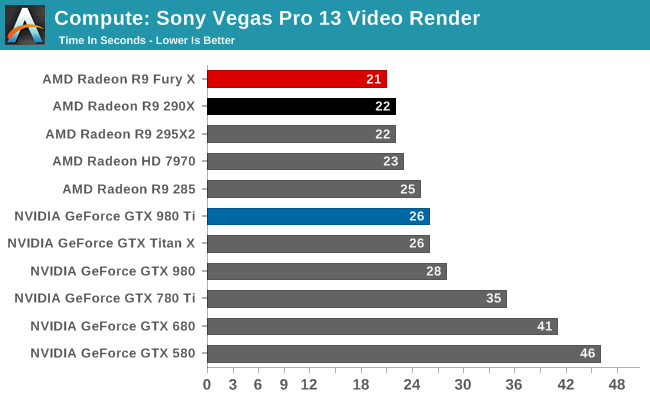
At this point Vegas is becoming increasingly CPU-bound and will be due for replacement. The Fury X none the less shaves off an additional second of rendering time, bringing it down to 21 seconds.
Moving on, our 4th compute benchmark is FAHBench, the official Folding @ Home benchmark. Folding @ Home is the popular Stanford-backed research and distributed computing initiative that has work distributed to millions of volunteer computers over the internet, each of which is responsible for a tiny slice of a protein folding simulation. FAHBench can test both single precision and double precision floating point performance, with single precision being the most useful metric for most consumer cards due to their low double precision performance. Each precision has two modes, explicit and implicit, the difference being whether water atoms are included in the simulation, which adds quite a bit of work and overhead. This is another OpenCL test, utilizing the OpenCL path for FAHCore 17.
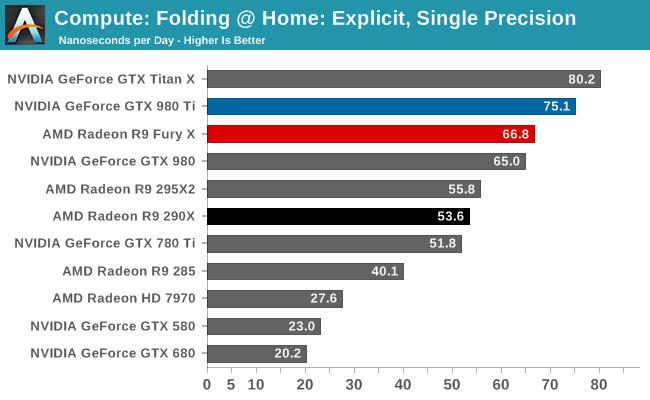

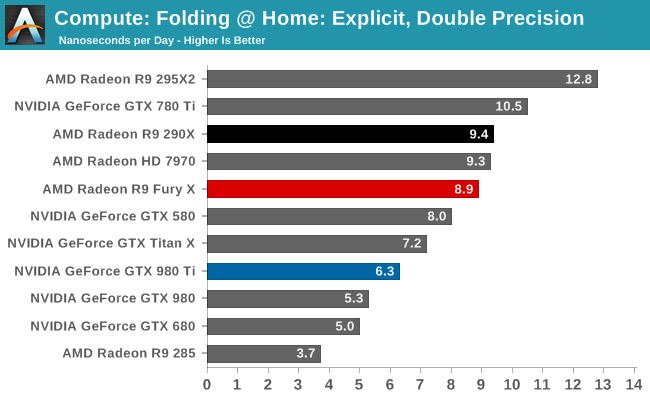
Both of the FP32 tests for FAHBench show smaller than expected performance gains given the fact that the R9 Fury X has such a significant increase in compute resources and memory bandwidth. 25% and 34% respectively are still decent gains, but they’re smaller gains than anything we saw on CompuBench. This does lend a bit more support to our theory about driver optimizations, though FAHBench has not always scaled well with compute resources to begin with.
Meanwhile FP64 performance dives as expected. With a 1/16 rate it’s not nearly as bad as the GTX 900 series, but even the Radeon HD 7970 is beating the R9 Fury X here.
Wrapping things up, our final compute benchmark is an in-house project developed by our very own Dr. Ian Cutress. SystemCompute is our first C++ AMP benchmark, utilizing Microsoft’s simple C++ extensions to allow the easy use of GPU computing in C++ programs. SystemCompute in turn is a collection of benchmarks for several different fundamental compute algorithms, with the final score represented in points. DirectCompute is the compute backend for C++ AMP on Windows, so this forms our other DirectCompute test.
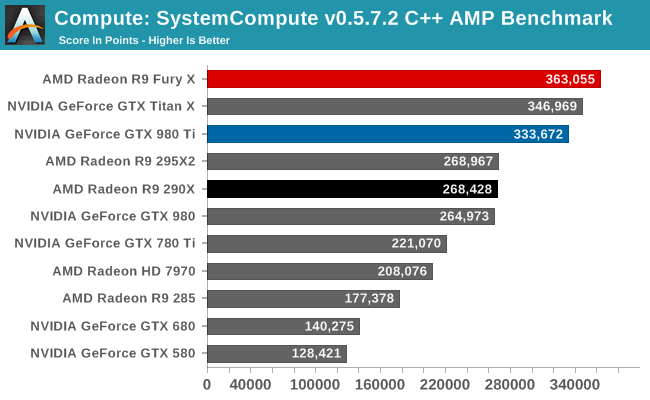
Our C++ AMP benchmark is another case of decent, though not amazing, GPU compute performance gains. The R9 Fury X picks up 35% over the R9 290X. And in fact this is enough to vault it over NVIDIA’s cards to retake the top spot here, though not by a great amount.










458 Comments
View All Comments
nader_21007 - Sunday, July 5, 2015 - link
As an analyst , I Guarantee AMD’s Success by taking the following simple steps:1. To Stop wasting money on R&D investments altogether at once.
2. To employ a bunch of marketers like Chizow, N7, AMDesperate, . . . to Spread Rumors and bash best products of the competition, constantly.
3. To Invest saved money (R&D wasted money on new techs like HBM, Low level API Mantle, Premium water cooler, etc, etc) in Hardware Review sites to Magnify your products Strengths and the competition’s Weaknesses.
(Note: Consumers won’t judge your product against the competition in practice, They just accept what they see in Hardware Review sites & Forums)
I just gave these advices to some companies in the past, and believe me, one have the best CPU out there, and the other make the best GPU. Innovation is not an R&D’s fruth, it’s a Marketing FRUTH.
Please contact me for more details, Regards.
Oxford Guy - Sunday, July 5, 2015 - link
Astroturfing got Samsung smacked with a penalty, but a smart company would hire astroturfers who are good at disguising their bias, not obvious trolls.SanX - Sunday, July 5, 2015 - link
AMD only hope left is that company with better lithography like Samsung for example buy it entirely. You're welcome, Samsung. Hope you will not forget my as always brilliant advices.amro12 - Sunday, July 5, 2015 - link
Why no 970? 290? At least a 970, it's better than that 290x up there...Oxford Guy - Sunday, July 5, 2015 - link
Perhaps because the 970 should have been withdrawn from the market for fraud? It should have been relabeled the 965 and consumers who bought one should have been offered more than just a refund.Innokentij - Monday, July 6, 2015 - link
To be from Oxford u seem to lack logical thinking.Oxford Guy - Thursday, July 9, 2015 - link
I'm logical enough to see a comment with no substance to it.chizow - Monday, July 6, 2015 - link
Of course this is nonsense, if the 970 launched at its corrected specs, would you have a problem with its product placement? Of course not. But let's all act as if this is the first and last time a cut down ASIC is sold at a lower price:performance segment nonetheless!Oxford Guy - Thursday, July 9, 2015 - link
Your post in no way rebuts what I wrote.Hxx - Monday, July 6, 2015 - link
right because that 0.5 partition really hindered its performance lol. Lets face it , the 970 is an excellent performer with more vram than last gen nvidia's top dog (870 ti) and performing within 15% from nvidia's top tier gtx 980 for $200 less...what more there is to say?